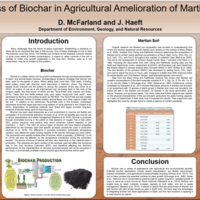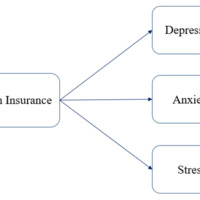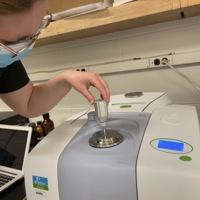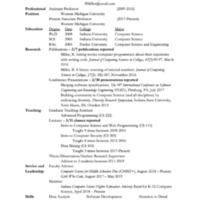Browse Exhibits (81 total)
Daniel Spencer | Beauty in Ruins

What constitutes beauty? Do we only find beauty in places that society tells us are beautiful? In this project, I address these questions and explore the idea of finding beauty in dilapidated places. This project consists of photographing urban ruins, editing the photos, and then composing ekphrastic poems to further amplify and expand on the photos’ meanings. By exposing the viewer to these derelict scenes, I hope to recalibrate the viewer’s own standards of beauty. I aim to shed light on the hidden beauty I see amongst these evident ruins.
Faculty Mentor: Charlie Geyer
Modern Languages and Classics
Undergraduate
Honors College
David McFarland | The Effectiveness of Biochar on Nutrient Retention in Martian Soil Simulant

This project will study the effects of biochar application on essential nutrient retention in a Martian soil simulant, Mojave Mars Simulant 2 (MMS-2). A potted plant experiment will be conducted using soybean plants planted in MMS-2, with and without biochar and fertilizer. It is hypothesized that the application of biochar will enhance benefits from fertilizer used with the simulant.
Faculty Mentor: Dr. Jessi Haeft
Department of Environment, Geology, and Natural Resources
Graduate
Delaney Long | Serotonin suppresses Drosophila serotonergic axon development in vitro
Serotonergic neurons modulate brain activity by releasing the neurotransmitter serotonin onto other neurons through long cable-like processes called axons. In order to successfully do this, axons from serotonergic neurons must precisely reach target neurons. If not achieved, malformed serotonergic axons can cause behavioral disorders impacting mood, sleep, and appetite. Assisting in this, serotonin regulates the development of axon structure in addition to its role as a neurotransmitter. Neurons unable to synthesize serotonin develop more branches and longer axons, suggesting it normally limits branching and elongation. Despite this observation, the molecular mechanism of this process, termed serotonin autoregulation, remains unknown. Here we developed a novel culture method allowing identification and analysis of developing primary Drosophila serotonergic neurons. To validate the utility of the culture system, we treated them with extracellular serotonin and found that high levels of serotonin inhibited axon growth. This is the first demonstration of serotonin autoregulation in a culture system, and combined with the powerful genetic tools available in Drosophila will provide exciting new insights into the molecular mechanism of serotonin autoregulation of serotonergic axon development.
Faculty Mentor: Douglas Roossien
Department of Biology
Graduate Student
Ellen Doss | Protein Quality Control in Candida albicans

Candida albicans is an opportunistic fungal pathogen that resides as normal flora in the human gastrointestinal tract and mouth. However, upon a patient’s immunosuppression due to a preexisting condition or an organ transplant, the yeast can colonize nearly every tissue and organ, causing life-threatening infections. Few treatment options exist for Candida infections; therefore, it is essential to understand the molecular mechanisms that contribute to its virulence. We are characterizing the roles of four genes involved in protein quality control, which is uncharacterized in C. albicans. Using CRISPR, we are generating homozygous deletions of HRD1, DOA10, UBC7, and STE24. These knockout strains are being characterized and compared to wild type yeast using growth assays to determine how well they grow in the presence of compounds predicted to increase the abundance of misfolded proteins. A virulence assay will then be performed utilizing a characterized insect infection model, Galleria mellonella wax moth larvae. Survival of larvae injected with each knockout strain will be compared to that of larvae injected with the highly virulent wild type strain. These experiments represent a novel investigation of protein quality control in C. albicans and have the potential to reveal new therapeutic targets for fungal infections.
Faculty Mentors: Dr. Eric (VJ) Rubenstein, Dr. Douglas Bernstein
Department of Biology
Graduate
Elli Cole | Graduate Students’ Health Insurance Needs: The Relationship to Depression, Anxiety, and Perceived Stress

Graduate students frequently report intense stress which contributes to susceptibility to mental health difficulties (Evans et al., 2018; Marks et al., 2011). They are six times more likely to experience depression or anxiety than non-graduate students. Many seek psychological treatment and 50% report considering seeking mental health services (Hyun et al., 2006). However, 46% cite financial constraints as a barrier to receiving services (El-Ghoroury et al., 2012). Currently, there is no research on graduate students’ health insurance, despite potentially being an underinsured population at risk for poor mental health. It was hypothesized that lack of health insurance would predict greater stress, depression, and anxiety in graduate students. Data was collected from graduate students at Ball State University (N = 65), who answered questions about health insurance, depression, anxiety, and stress. The results indicated 21% of students did not have health insurance. A multivariate analysis of variance was used to assess how a lack of health insurance was associated with depression, stress, and anxiety. The results suggested there were significant differences between the groups F3,61 = 334.67, p < .001 and lack of health insurance accounted for 13% of the variance in depression, stress, and anxiety. Discriminant analysis suggested that depression was most strongly associated with differences between groups (.67) followed by stress (.25) and anxiety (.01). The need for health insurance and the mental health of graduate students is discussed.
Faculty Mentor: Anjolii Diaz, Ph.D.
Psychological Science
Graduate
Emily Hayes | Peace and Water in the Khumbu- Mitigating Conflict by Integrating Peacebuilding Tools into an Indigenous Water Management Framework
Threats of climate change and increasing foreign tourism have extraordinary impacts on drinking water quality and availability for the indigenous and local people of the Sagarmatha National Park (SNP), Nepal. The purpose of this study is to expand on six years of previous water quality research of the SNP, focusing on local indigenous water management practices and the dynamic relationship between water management and peace. Using a mixed-methods, participatory action research approach, this study intends to: (1) understand local and tourist perceptions and attitudes regarding water resource management; (2) identify possible conflicts associated with water resources; and (3) develop community action strategies and a community-based plan of action to address water quality issues related to conflict.
Faculty Mentor: Joshua Gruver
Secondary Mentors: Dr. Kirsten Nicholson, Dr. Subodh Sharma
Dept. of Environment, Geology, and Natural Resources
Graduate Student
Emily Turner | The Parasite of Society
Food studies in media provide complex layers to the films that viewers quite literally consume, a fact complicated depending on how one analyzes food. Different theories, lenses, and contexts can change how food is used in film, much like how using different ingredients in a recipe can alter the final product. But why does food matter in film, and how do directors use food to create meaning? Food is often employed to symbolize greater significance or to prove a point that a director wants to assert in their film. For example, Bong Joon-ho’s film Parasite (2019) utilizes food to symbolize social class: food is a vehicle in this film to show both the stark divide between the upper and lower classes and how such economic disparity can be perilous for society. Bong does this to warn viewers that class inequality is unjust by demonstrating how greed within different social classes warrants grave consequences. Ultimately, Parasite concludes with the patriarch of the ultra-wealthy Park family deceased while the extremely impoverished Kim family is divided, still dangerously poor, and suffering the death of their daughter/sister. While these may be extreme conclusions to draw from the film, Parasite aims to warn its viewers of the greed between social classes that could lead to such dismal ends. Bong accomplishes this through the placement of food: it symbolizes the class divide that each family struggles with in different ways.
Faculty Mentor: Emily Rutter
Department of English
Undergraduate
Emma Cieslik | Hot Button Issue: Material Composition Analysis of Archaeological Ceramic Buttons

This research analyzed 10 buttons recovered from an archaeological site for composition. The buttons were excavated from an unmarked 19th century African American cemetery in Lowndes County, Mississippi. Each button was sampled, and infrared spectra were obtained for each sample using Fourier Transform infrared spectroscopy. The unprocessed spectra were deconvolved, and a fourth derivative of spectra were obtained to check the validity of the peaks. Replicate spectra of each button were also obtained.
Preliminary project results indicate that the majority of button samples may be composed of a mixture of different types of feldspars, a group of technological minerals, clay, and sillimanite. Reference spectra for each feldspar type is very similar and makes distinct feldspar identification difficult. The spectral data indicate that these buttons are composed of materials consistent with the Prosser button method production. Prosser buttons were commonly used for clothing from 1840 onward (Sprague 2002). According to the patent, Prosser buttons were composed of flint and clays. Unlike the higher-quality Prosser buttons that were often made from ground quartz, these buttons were likely made of ceramic wasters, including a combination of the aforementioned feldspars.
These results contribute to the field of feldspar identification, material composition identification of archaeological artifacts, and the production profile of buttons dating to the Civil War period. Understanding button production provides interesting insight into industrial methods and clothing history.
Faculty Mentors: Dr. Patricia Lang (Department of Chemistry) and Dr. Homes Hogue (Department of Anthropology)
Department of Chemistry and Department of Anthropology
Undergraduate
Honors College
Eric Wilken | The Impact of Grant Funding on Economic Growth in Ohio: A Spatial Approach
Economic growth is often not distributed uniformly across a country or state. This provides obligation to governments to provide assistance, such as grants, to reduce economic inequality between subregions. This thesis investigates how the allocation of Ohio state grant funding impacts economic development between counties. Data were retrieved from archival data sets available between the years 2010 through 2014. The data were analyzed to consider the spatial interaction between counties as the economic activity within cities can impact the economic activity in surrounding rural areas (Henry & Drabenstott, 1996). First, an OLS regression was conducted for each year of data and analyzed to determine if spatial autocorrelation was present. Then, spatial effects were captured by conducting regressions utilizing the spatial error model, the spatial lag model, and the spatial Durbin model. The spatial models and OLS model were compared using their AIC and BIC values. The results suggest spatial regression was not preferred to OLS in modeling the impact of grant funding, in the years 2010 through 2014. Additionally, according to our model, grant funding over the 5-year period had a small and statistically non-significant impact on overall economic activity in Ohio. However, the results also indicate spatial regression will likely continue to become more important in the analysis of grant funding due to both the theoretical implications and the presence of growing spatial economic inequality. This study opens several avenues for future research such as the substitution of the one-year and 5-year growth rates of real GDP per capita for the dependent variable and investigating the trend of spatial autocorrelation in years after 2014.
Faculty Mentor: Dr. Rebecca Pierce
Department of Mathematical Sciences
Graduate
Erin Kaihara | Evaluations of Applicants for a Leadership Position in a Male-Dominated Academic Field: The Role of Gender and Race

The current study analyzed how gender and race play a role in the hiring process of candidates for a male-dominated position in academia. Specifically, this research looked at how Hispanic/Latinx individuals compare with White individuals when applying to be the head of a computer science department at a university.
Faculty Mentor: Dr. Katie Lawson
Psychological Science
Undergraduate
Honors College
